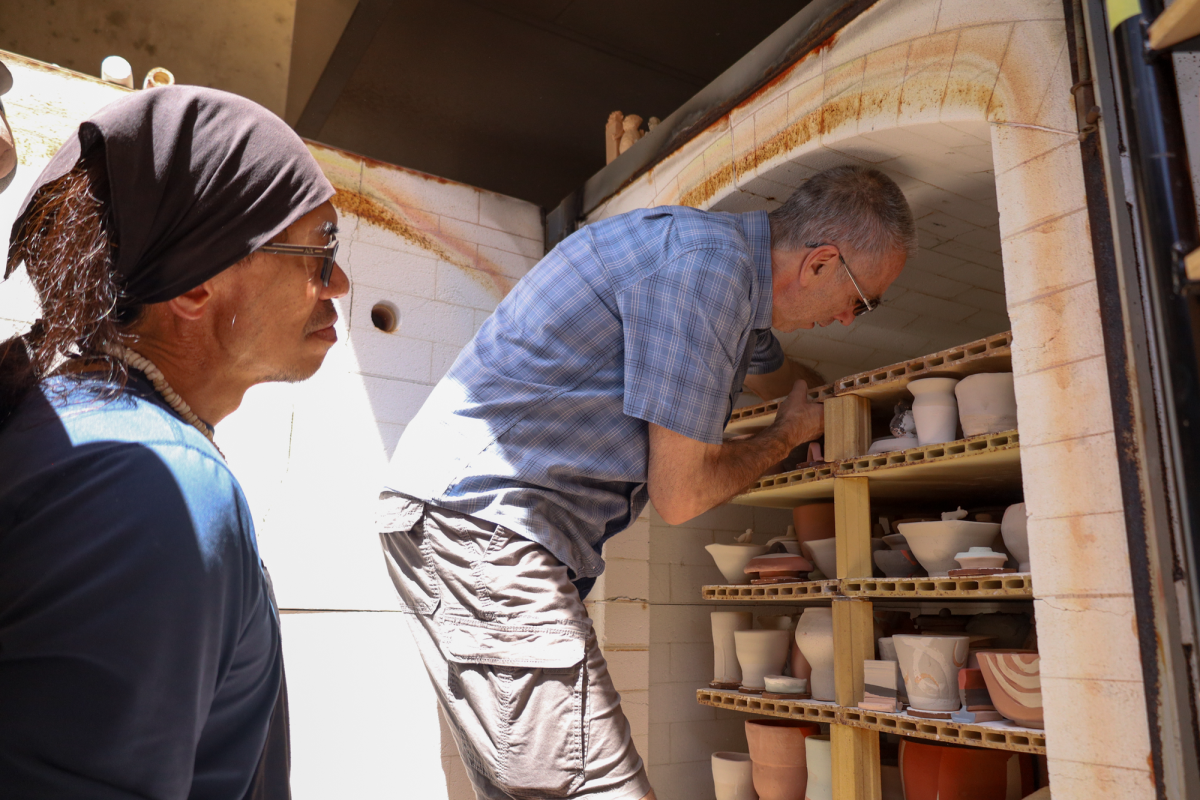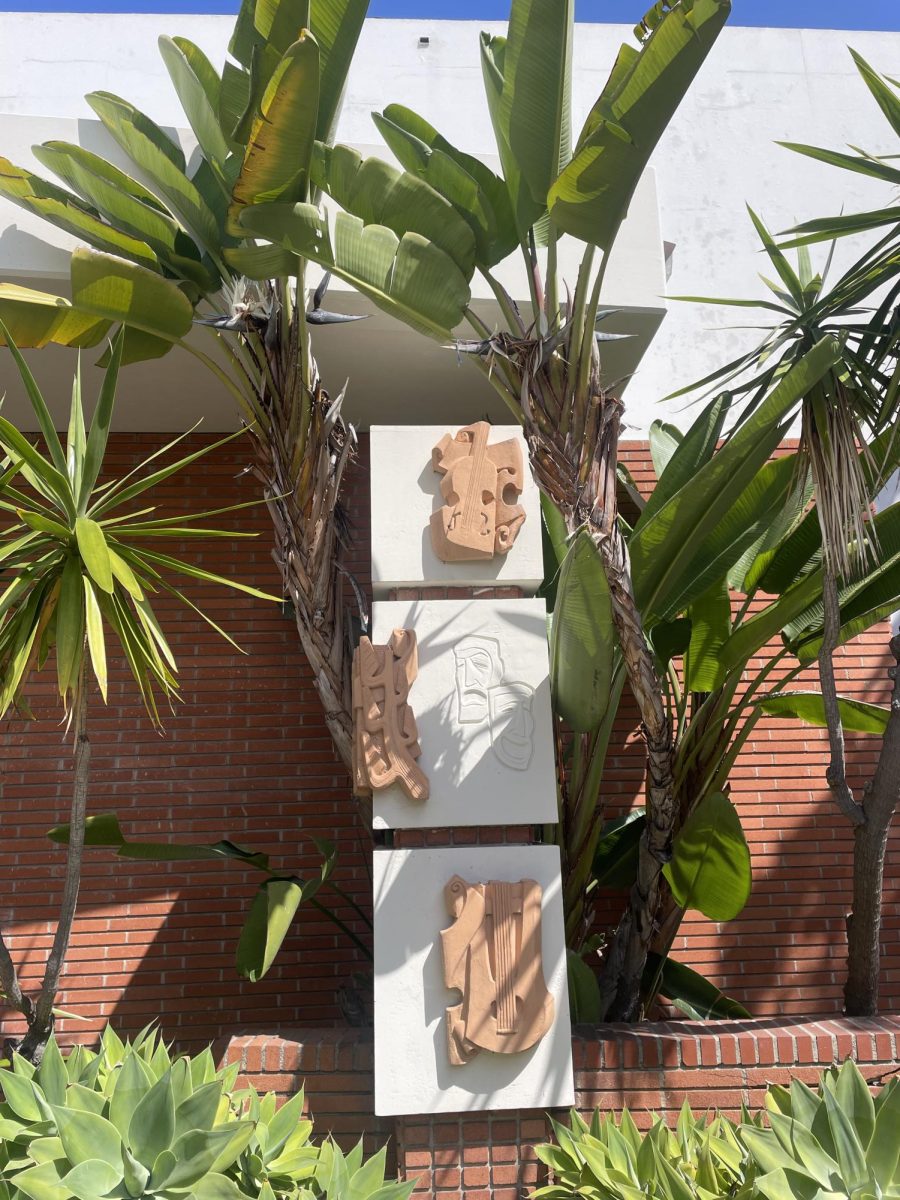No one is sure when the coyotes first appeared.
They seemed to come out of nowhere. It was as if, one foggy night, the coyotes suddenly materialized out of the mist like a nightmare straight out of a Stephen King novel.
Within 10 years, the once-thriving community of 300 cats who call El Camino College home has been whittled down to sparse colonies totaling somewhere between 30 to 50 cats.
The life of an El Camino cat has become more precarious since the recent pandemic. But they are not alone in their fight for survival. One man, backed by a dedicated network of volunteers, has made it his mission to help one of the most vulnerable groups on campus.
Carl Turano is a warehouse stock clerk who has been working at El Camino College since 1999. He is a tall, wiry man of 62 who speaks in a low and gentle voice. He can be spotted around campus from time to time in a bright sunflower yellow Taylor Dunn utility buggy.
When he is in his uniform, which includes a weatherbeaten brown outdoor hat with a mesh crown and a blue El Camino College utility shirt, Turano comes across as one part cowboy and one part first responder.
Turano started as a custodian working the night shift in 1999. That was when he met the woman who changed his life forever.
Mary Semeraro had been working at El Camino College as a physical education instructor who coached softball and volleyball since 1966. She had already retired by the time Turano joined the staff. But she wasn’t going to let retirement didn’t stop her from visiting the campus every night.

“Mary was creeping around here at night, feeding kitties,” Turano recalls of his old friend. “She was moving so slow and stiff and I felt bad for her. I started helping her and then I started hanging out with her more. She was very good to me.”
Taking care of cats isn’t new for Turano. He is a lifelong animal lover whose desire to help others goes back to his childhood.
When he was a boy growing up near Rochester, New York, Turano rescued a stray gray kitten. That cat was named Smokey and lived another 18 years under his care. He even tagged along when the Turanos moved from New York to California.
In the following years, Mary and Turano visited the campus every night to feed the cats. They forged an indestructible bond, almost like a mother and son.
Mary became a mentor to Turano, introducing him to the many cat colonies spread out across the 26-acre campus.
Penny is the unofficial Queen of El Camino College and Mary’s favorite. She is a calico with large blotches of muted brown, gray, and white fur on her back who loves to sunbathe by the succulents near the Bookstore. She has been living at El Camino for the better part of 16 years.
Peggy is a grey tabby and a bit of a loner who can be seen hanging around the Humanities Building.
Most cats don’t have official names. A tuxedo cat with a thick mustache lingers by the library. A grey-and-white tom with a bobbed tail loiters around Stadium Way. Another grey-and-white unfixed tom dubbed “Gaston” is known to roam around the art buildings and the Bookstore. He has been pursuing a shy little tortoiseshell, but she isn’t interested in him.
Turano calls her “Miss Kitty” when he feeds her.
“I want his balls,” Turano says, shaking his head as he passes by Gaston’s usual haunt near the Bookstore. He has been trying to trap and release Gaston for years, but he is cunning. He knows what those metal cages are really for. He is an old-timer who has been on campus for years and knows a thing or two about survival.
Trap-Neuter-Return is a program where the feral cat population is caught and taken in for a medical evaluation. This may include spaying or neutering the cats to control the population.
An unneutered male cat, or any unfixed cat, poses a hazard. Cats begin breeding as early as four months and will produce a litter of four to six kittens within nine weeks. This can go on for years. As a result, a population boom overwhelms animal shelters in an already strapped and strained system.
“This past year took a turn. We saw more animals coming into the shelters,” Ana Bustilloz said. She is the director of communications and marketing for spcaLA. “People are losing their homes, or they have to relocate and live where no pets are allowed. Or they can’t afford the pet care anymore.”
While spcaLA has seen a steady adoption rate in the past few years, the flood of animals coming in strains the system. As Bustilloz puts it, “For every five we adopt, six more come in.”
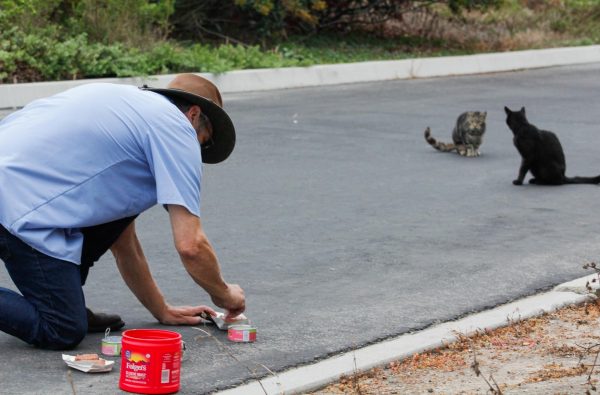
Day by Day
Carl Turano’s workday begins at dawn. He pulls up to the Receiving Facilities warehouse on Manhattan Beach Boulevard on a wine-colored Schwinn Meridian tricycle. The tricycle used to belong to his wife, but he finds it useful when commuting from his home in Lawndale.
The large black wirework basket in the back rattles with cans. Fancy Feast. Friskies. The brand doesn’t matter as long as it’s pate.
Turano feeds the cats before his shift is scheduled to begin. He’s received pushback from the college for feeding the cats over the years.
Back in 2020, there was an incident in which a neighbor reported Turano to the college for feeding the cats. An investigation later revealed that the neighbor and his dog were harassing the cats. Nevertheless, Turano received a letter reminding him that “feeding cats is to be done on [his] personal time.”
Turano loads the supplies onto the bed of his signature ride: a bright yellow Taylor Dunn buggy. In addition to the cans, he adds a jug of fresh water. A large grey tub with a screw-on lid is halfway filled with dry food. Once he is sure everything is ready, Turano takes off for the first of his many stops of the morning.
The first colony waits patiently under the ramp of the Facilities Construction Management building. This is a quartet of three tabbies and one butter-colored cat.
They swarm around Turano’s ankles as he washes out the coffee can lids and plastic dishes that act as makeshift bowls. He prefers these because they are plentiful. If one goes missing, it can be replaced.
Turano carefully opens the cans and divides each portion in half. One can is enough to feed two cats. He gives out enough dry food so that the raccoons and other critters don’t try and take more.
On average, Carl Turano will use up to 10 cans a day. He pays for whatever supplies he will need and relies on donations.
Sometimes, he will get a shipment of wet food from a generous donor. On the menu today is Kirkland Signature pate. It was a contribution from an El Camino employee whose own cat didn’t care for it.
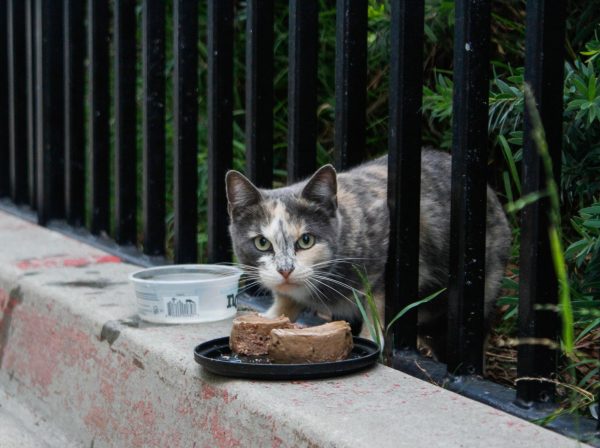
Once the quartet is fed, he moves on to his next stop. For the next hour, Turano takes his buggy around campus and visits his friends.
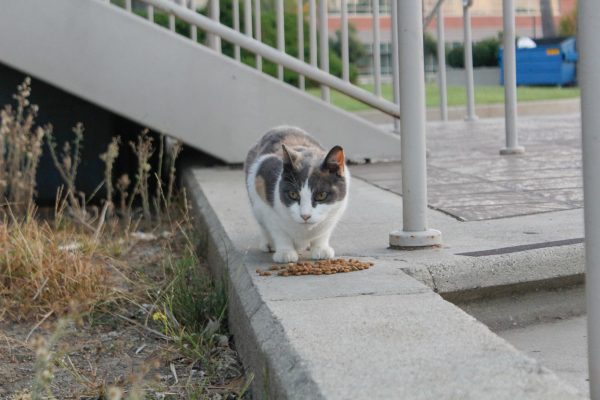
The colonies live in the hidden corners of the campus, just out of sight from the regular hustle and bustle as students go about their day. As their caretaker, Turano is privy to their secrets.
Turano heralds his arrival with a low whistle. As soon as they hear the breakfast call, the cats appear. They poke their heads out from shrubs and materialize from behind buildings and waist-high grass. He takes the time to portion out the food carefully, calling them “mama” or “pretty” as they inch closer to him and accept his offerings.
Turano quickly points out one of their safe spaces as he drives by the old Art-North Building. Cats such as Gaston are known to hide on the roofs of old art buildings.
“When the coyotes come,” Turano said, “they’ll get on the roof. The coyotes can jump 12 feet and they systematically go for cats.”
Passing by the newly opened Arts Complex, he notes how no cat colonies are living there yet, but they may move there one day.
As El Camino College continues to change its landscape, the cats also adapt to their new surroundings.
The Rescue
Carl Turano is just finishing his rounds for the morning when he gets the call. “Is that right,” he asks, phone pressed against his ear. His head is tipped so low that the brim of his brown outdoor hat shades his eyes from the low early autumn sun. “Big cat or little cat?”
A split second later, he jumps into the cab of his buggy and takes off.
Within minutes, he pulls up to the sally port of the El Camino College police department. Officer Erika Solorzano waits for him in the courtyard, a medium-sized grey kennel at her feet. A pair of large golden eyes as bright as headlights peer between the metal bars of its cell.
The inmate is a small orange tabby with a white bib and scruffy matted paws. He roams restlessly inside, meowing nervously.
The cat was taken into custody by a cadet at around 10 p.m. the night before. He was then held overnight by police until he could be released into Turano’s care.

After being released from lockup, an orange cat looks up at Carl with a look of trust on Thursday, Sept. 28. He was abandonded on campus and was soon taken into custody overnight by El Camino College police. Within a week, the cat was adopted by a family thanks to the efforts of Carl and the Cat Care Club. Photo credit: Monroe Morrow
Solorzano called Turano because she knows the cat will be in good hands.
“I know he loves cats,” Solorzano said. “And he takes care of them and feeds them. He’s been part of a group that I know feeds the cats on campus.”
The group that Solorzano is referring to is the El Camino Cat Care Club. It is a network of volunteers whose mission is to provide food and care for the cats. Carl and his wife, Debbie, first started this as a means to keep members in touch with the goings-on around campus.
In the past, the members would meet at each other’s homes. There, they would coordinate club activities such as TNR.
Since the pandemic, members have not been able to meet face-to-face. But they have never stopped caring for the cats.
Volunteers, including Elise Geraghty, a full-time English professor, have carved out their niche in sustaining the El Camino College cat colonies.
Geraghty has been caring for the cats near the Humanities Building since 2011. Once a thriving colony, it has been whittled down to Peggy, the lone survivor. The others had been picked off by coyotes over the years.
Among the fallen is Don Cornelius, a beloved icon of the campus.
“He was the dean of the humanities campus cat,” Geraghty recalls lovingly. Don, a black tom, was abandoned. He soon found his place at El Camino, where he met his best friend, Orange, a tabby.
Don Cornelius and Orange shared many happy years together until tragedy struck. Sometime during the night, between Dec.15 and 16, 2018, Don Cornelius was killed in a wildlife attack. In his old age, he couldn’t outrun his assailant.
His death was covered in a December 2018 article for “The Union.” As of 2023, his murder remains unsolved. It is believed that a coyote attack took his life.
Cats are not native to El Camino College, but coyotes are. As urban development projects began to take root across the South Bay, coyotes were displaced from their natural habitats and were forced to find a way to survive.
“Coyotes go after cats because they are predators, that’s what they do,” Turano said. “Certain colonies hang out together and they don’t take new kitties. So that’s how the coyotes get them. They’re smart. They systematically catch up to them.”
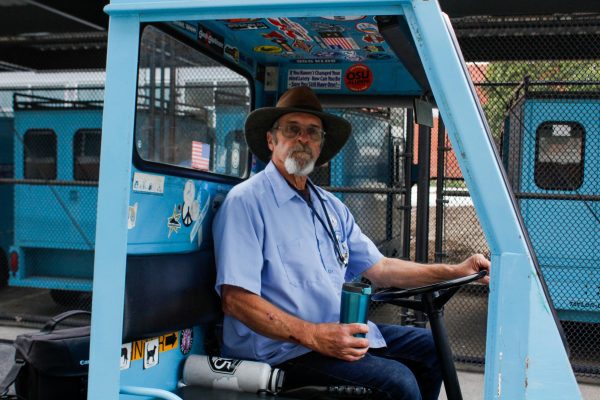
By 2019, El Camino College had installed Nite Guard lights around campus to deter coyotes. By then, the damage was done. Countless cats lost their lives. Besides Don Cornelius, the fallen include Orange, who passed shortly after his friend. Penny lost her daughter to the attacks.
El Camino staff who aren’t members also step in to help.
Gary Crawford is an unofficial volunteer. He is a groundskeeper who has worked with Carl for 12 years. His jurisdiction is the west side of the campus, near the baseball fields.
“I love cats,”’ Gary said. He beams when he thinks of a particularly special cat he came across.
“I actually had one of the cats that was dropped off here. I took care of him for five months and I ended up adopting him.”
That is the outcome Turano hopes to get for the little orange stray sitting in the back of his buggy. After leaving the station, he drives a short way to the west side of campus. Once he’s in a quiet area away from prying eyes, he gets to work.
He calls Debbie.
“Hey babe, I got another cat,” he greets her. After a few minutes, he pauses to get a few pictures of the kitten.
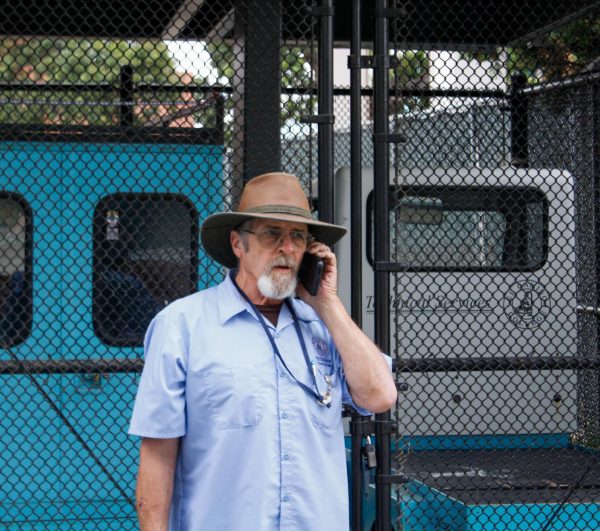
These will go on the El Camino Community Cats Facebook page, where over 300 members will see the post.
Turano hopes that word will get around and they can find a good home for the cat.
“The problem with dumping a cat on campus is that you’re not providing a good life,” Debbie Turano said. While a feral cat was born to survive, a cat who came from a home and depended on others for food and shelter is left at a severe disadvantage.
Debbie Turano said there are risks when abandoning cats on campus. They are surrounded by streets and could get hit by cars. They deal with coyotes, who will eat them. Cat colonies are territorial, so they don’t always accept new members. Without a colony to guide them, the strays are left to struggle alone.
As Carl Turano gets photographs, the orange cat rubs against the bars. He is friendly and quickly warms up to him. After the battery of medical tests and shots, he hopes the cat will find a new home soon. He feels good about this one.
“I will continue to take care of the cats for as long as I am able to,” he said. “They are my friends.”
Editor’s Note: Additional photos were added on Dec. 8, at 6:02 p.m.





